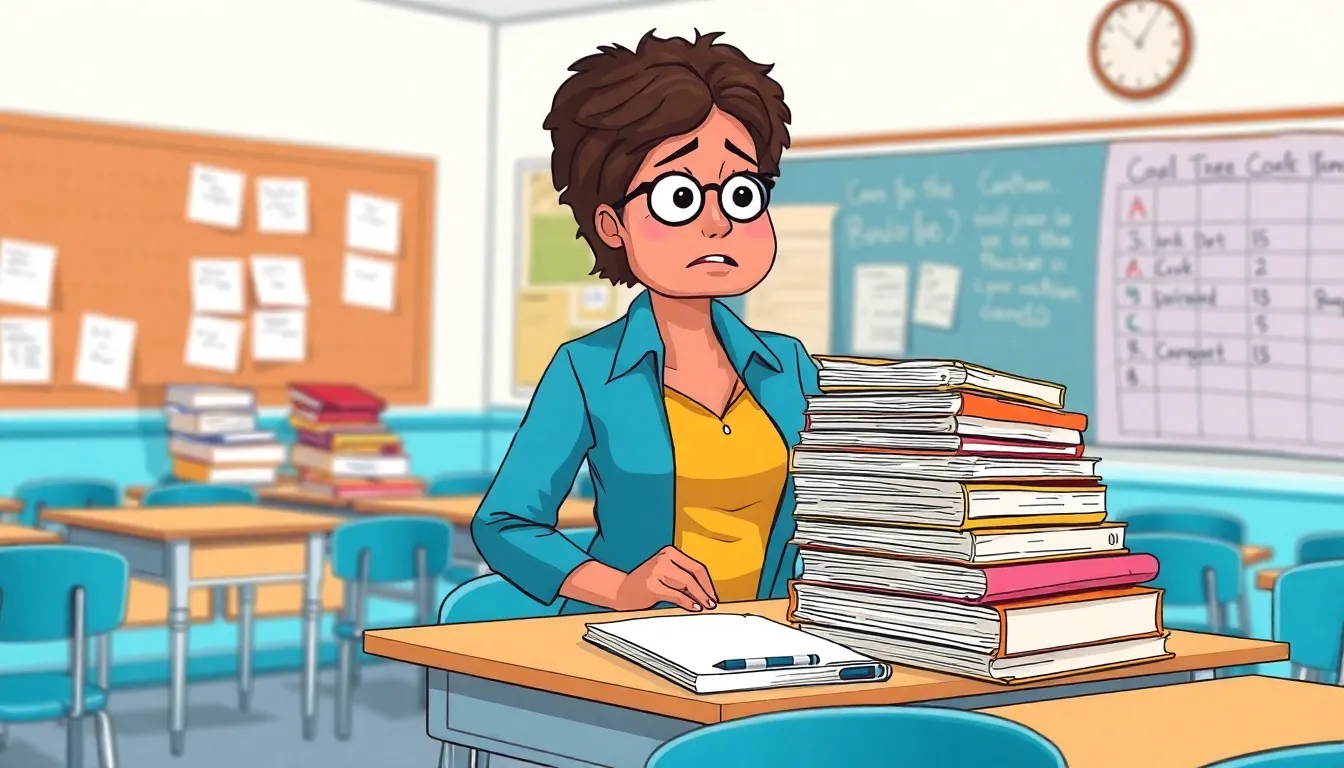Table of Contents
ToggleEducation today faces challenges that could make even the most optimistic teacher sigh. From overcrowded classrooms to outdated curricula, the struggle is real. Imagine trying to teach a group of students while dodging flying paper airplanes and the occasional rogue smartphone. It’s a circus out there, and the ringmaster is nowhere to be found.
But it’s not all doom and gloom. These problems highlight the urgent need for change and innovation. With the right focus and strategies, we can turn this educational circus into a well-orchestrated performance. By addressing the core issues, educators can create an environment where learning thrives and students actually want to participate. So grab your popcorn and get ready to explore the wild world of education today, where solutions await just around the corner.
Problems In Education Today
Overcrowded classrooms hinder personalized learning. A significant ratio of students to teachers makes it difficult for educators to address individual needs effectively. Recent studies indicate that class sizes exceeding 30 students lead to lower student performance, highlighting the need for smaller groups.
Outdated curricula fail to engage students. Many educational programs lack relevance to real-world situations, leaving students unprepared for future challenges. Adapting the curriculum to include technology, critical thinking, and problem-solving skills remains essential for fostering student interest and success.
Insufficient funding significantly limits resources. Many schools struggle to provide basic supplies, such as textbooks and technology, impacting the overall learning experience. According to the National Center for Education Statistics, the average spending per student has decreased over the past decade, illustrating a pressing need for increased financial support.
Standardized testing measures alignment rather than understanding. While testing can assess knowledge retention, it often pressures students to focus on memorization instead of genuine learning. This approach affects creativity and critical thinking abilities, essential skills in today’s job market.
Teacher burnout affects classroom effectiveness. High workload and low morale contribute to decreased teacher retention, leading to a shortage of qualified educators. Consequently, students experience disrupted learning environments as new teachers require time to adapt.
Access to mental health resources remains inadequate. Many students face emotional and behavioral challenges without proper support systems in place. Schools that invest in mental health services report improved academic outcomes, confirming the necessity for accessible mental health resources.
Addressing these problems requires a holistic approach. Educators, administrators, parents, and policymakers must collaborate to implement effective solutions that prioritize student well-being and academic achievement. With targeted efforts, the education system can evolve to meet the needs of all students.
Lack Of Funding

Lack of funding significantly affects educational institutions, leading to compromised learning environments and limited resources.
Impact On Resources
Insufficient funding creates a scarcity of educational materials. Schools often lack access to updated textbooks and technology. As a result, students miss out on essential tools that facilitate modern learning. Libraries frequently operate with minimal resources, limiting research opportunities. Extracurricular programs suffer too, with fewer options available for student engagement. When funding gaps exist, teachers face challenges in delivering effective lessons, impacting knowledge retention. These resource constraints can hinder a school’s ability to provide a well-rounded education.
Teacher Salaries
Low teacher salaries contribute to recruitment and retention issues in education. Many educators leave the profession for better-paying jobs elsewhere. Salary disparities between regions and states create imbalances in teacher staffing. When schools can’t offer competitive wages, attracting skilled educators becomes difficult. As a consequence, experienced teachers often experience burnout, leading to higher turnover rates. Teacher salaries directly influence the overall quality of education that students receive, making adequate funding essential for maintaining a stable teaching workforce.
Inequality In Education
Inequality remains a prominent issue in education today. Socioeconomic status often dictates the quality of education a student receives, leading to significant disparities.
Socioeconomic Disparities
Limited resources impact low-income students disproportionately. Schools in affluent areas typically enjoy better funding and facilities, while schools in less wealthy neighborhoods often struggle. High poverty rates correlate with lower test scores and graduation rates, which suggests a direct link between income and academic achievement. Additionally, students facing financial challenges may lack access to essential services, such as tutoring or after-school programs, further widening the educational gap. Addressing these imbalances requires targeted interventions to create equitable learning opportunities for all students.
Access To Technology
Technology gaps exacerbate educational inequality. Students in underfunded schools often lack access to computers and high-speed internet, which are crucial for completing assignments and engaging in digital learning. Many lessons now incorporate online resources, making technology access essential for academic success. Disparities in technology can hinder students’ ability to prepare for a technology-driven workforce. It remains vital for policymakers to invest in infrastructure and provide devices to bridge this technological divide, ensuring all students can benefit from modern educational tools.
Curriculum Relevance
Curriculum relevance directly impacts student engagement and preparedness for the future. Outdated materials and teaching methods often fail to resonate with today’s learners.
Outdated Teaching Materials
Textbooks and instructional resources can become outdated quickly. Many schools lack access to current publications, limiting students’ exposure to contemporary knowledge. Outdated teaching materials can discourage engagement and hinder understanding of critical concepts. Teachers often struggle to supplement these materials with current information due to budget constraints. Additionally, access to technology and online resources presents an opportunity for improvement, yet many institutions fall short in providing these tools. Continuous professional development for educators also helps address these gaps in resources, enhancing their adaptability to modern teaching methods and materials.
Skills Gap For Future Jobs
A significant skills gap exists between students and the demands of the workforce. Education systems frequently focus on rote memorization rather than real-world application. This disconnect leaves students unprepared for careers in rapidly evolving fields. Many employers prioritize critical thinking, problem-solving, and communication skills. Schools must respond to these needs by integrating technology and hands-on learning experiences into the curriculum. Equipping students with relevant skills requires collaboration with industry professionals to ensure that education aligns with job requirements. By addressing these gaps, schools can better prepare students for successful futures in a competitive landscape.
Mental Health Challenges
Educational institutions face significant mental health challenges, affecting both students and teachers. Addressing these concerns is crucial for fostering a conducive learning environment.
Student Stress And Anxiety
Student stress and anxiety levels continue to rise, leading to detrimental effects on academic performance. Research indicates that roughly 30% of students experience chronic stress related to school demands, social pressures, and family expectations. Frequent assessments add to this burden, causing students to focus on grades instead of learning. Mental health issues can also result in absenteeism, with students missing classes due to overwhelming pressure. Resources for managing stress often remain inadequate in many schools, leaving students without proper support. Increased awareness and proactive measures are essential for creating a healthier academic atmosphere.
Support Systems In Schools
Support systems in schools play a vital role in promoting mental well-being. Many schools lack sufficient mental health professionals, resulting in inadequate student support. Effective programs can include counseling services, peer mentoring, and wellness workshops, addressing the diverse needs of students. Schools that implement mental health initiatives report improved student engagement and academic performance. Encouraging communication between educators, parents, and mental health professionals strengthens these systems. Prioritizing mental health resources contributes significantly to overcoming the challenges students face, ensuring they receive the help they need to thrive academically and emotionally.
Addressing the problems in education today requires a collective effort from all stakeholders. By recognizing the impact of overcrowded classrooms outdated curricula and insufficient funding, it’s possible to create a more equitable learning environment. Prioritizing mental health resources and modernizing teaching methods can significantly enhance student engagement and success.
As the education landscape continues to evolve, embracing innovation and collaboration will be essential. With a commitment to reform and investment in resources, educators can better prepare students for the challenges of tomorrow. The journey towards a more effective education system is ongoing but achievable with focused action and dedication.







